Predictions of the Effect of Non-Homogeneous Ocean Bubbles on Sound Propagation
Abstract
:1. Introduction
2. Theory
2.1. Single Bubble
2.2. Coupling Model
2.3. Multiple Bubble Layer Model
3. Simulation
3.1. Homogeneous Bubbles
3.2. Non-Homogeneous Bubbles
- 1.
- Same quantity distribution;
- 2.
- Gaussian distribution;where = 60 m, .
- 3.
- Power exponent distribution.where m represents the power index, here, we set .
4. Conclusions
- Adding a small amount of bubbles can greatly increase the attenuation coefficient of the medium at a specific frequency;
- The position of the bubble layer affects the spatial distribution of the sound pressure but has no obvious effect on the overall attenuation of the bubbly liquids;
- Bubble distribution is the main factor affecting sound propagation. Under the same volumetric void fraction, the same quantity and Gaussian-distributed bubbles have the largest backscattering and the smallest transmittance at low frequencies. The backscattering of the power exponentially distributed bubble layer increases with the increase in frequency, and the transmittance decreases gradually.
- 1.
- It can adapt to various conditions of the non-homogeneous distribution of bubbles, providing strong support for the subsequent study of the spatial propagation law of sound waves in underwater non-homogeneous bubble sound fields;
- 2.
- The attenuation of the medium itself and the attenuation caused by bubble vibration work together, and the influence of bubble scattering is added to the forward propagation, which is more realistic than the previous simulation model under ideal conditions and corrects the errors caused by ignoring these effects;
- 3.
- As a special underwater scatterer, bubbles are propagated in the form of point sound sources in this model, which can better reflect the influence of bubble group vibration and scattering on sound wave propagation and realize the calculation of backscattered sound pressure of non-homogeneous distributed bubbles;
- 4.
- When the calculation distance is 6 m, the calculation speed of the multiple bubble layer model is 2.85 times that of the coupling model, and the difference in calculation speed is greater with the increase in distance. Moreover, the memory occupied by the multiple bubble layer model is proportional to the distance, while the memory occupied by the coupling model is proportional to the square of the calculated distance.
Author Contributions
Funding
Institutional Review Board Statement
Informed Consent Statement
Data Availability Statement
Conflicts of Interest
References
- Commander, K.W. Linear pressure waves in bubbly liquids: Comparison between theory and experiments. J. Acoust. Soc. Am. 1989, 85, 732–746. [Google Scholar] [CrossRef]
- Commander, K.W. Off-resonance contributions to acoustical bubble spectra. J. Acoust. Soc. Am. 1989, 85, 2665–2669. [Google Scholar] [CrossRef]
- Sornette, D. Acoustic wave propagation in one-dimensional stratified gas–liquid media: The different regimes. J. Acoust. Soc. Am. 1991, 92, 296–308. [Google Scholar] [CrossRef]
- Prosperetti, A. Active and passive acoustic behavior of bubble clouds at the ocean’s surface. J. Acoust. Soc. Am. 1993, 93, 3117–3127. [Google Scholar] [CrossRef]
- Prosperetti, A. A general derivation of the subharmonic threshold for non-linear bubble oscillations. J. Acoust. Soc. Am. 2013, 133, 3719–3726. [Google Scholar] [CrossRef]
- Lyons, A.P. Predictions of the acoustic response of free-methane bubbles in muddy sediments. J. Acoust. Soc. Am. 1994, 96, 3217–3218. [Google Scholar] [CrossRef]
- Ye, Z. Acoustic dispersion and attenuation relations in bubbly mixture. J. Acoust. Soc. Am. 1995, 98, 1629–1636. [Google Scholar] [CrossRef]
- Shagapov, V.S.H. Acoustic waves in a liquid with a bubble screen. Shock Waves 2003, 13, 49–56. [Google Scholar] [CrossRef]
- Shagapov, V.S.H. Refraction and reflection of sound at the boundary of a bubbly liquid. Acoust. Phys. 2015, 61, 37–44. [Google Scholar] [CrossRef]
- Vanhille, C. Nonlinear ultrasonic waves in bubbly liquids with nonhomogeneous bubble distribution: Numerical experiments. Ultrason. Sonochem. 2009, 16, 669–685. [Google Scholar] [CrossRef]
- Vanhille, C. Simulation of nonlinear ultrasonic pulses propagating through bubbly layers in a liquid: Filtering and characterization. J. Comput. Acoust. 2011, 18, 47–68. [Google Scholar] [CrossRef]
- Vanhille, C. Two-dimensional numerical simulations of ultrasound in liquids with gas bubble agglomerates: Examples of bubbly-liquid-type acoustic metamaterials (blamms). Sensors 2017, 17, 173. [Google Scholar] [CrossRef]
- Vanhille, C. Numerical simulations of the nonlinear interaction of a bubble cloud and a high intensity focused ultrasound field. Acoustics 2019, 1, 825–836. [Google Scholar] [CrossRef]
- Chong, K.J.Y. The effects of coupling and bubble size on the dynamical-systems behaviour of a small cluster of microbubbles. J. Sound Vib. 2010, 329, 687–699. [Google Scholar] [CrossRef]
- Zhang, Y. A generalized equation for scattering cross section of spherical gas bubbles oscillating in liquids under acoustic excitation. J. Fluids Eng. 2013, 135, 091301. [Google Scholar] [CrossRef]
- Zhang, Y. Effects of mass transfer on damping mechanisms of vapor bubbles oscillating in liquids. Ultrason. Sonochem. 2018, 40, 120–127. [Google Scholar] [CrossRef]
- Zhang, Y. Influences of bubble size distribution on propagation of acoustic waves in dilute polydisperse bubbly liquids. J. Hydrodyn. 2019, 31, 50–57. [Google Scholar] [CrossRef]
- Zhang, Y. Interior non-uniformity of acoustically excited oscillating gas bubbles. J. Hydrodyn. 2019, 31, 725–732. [Google Scholar] [CrossRef]
- Zhao, J. Study on the Acoustic Reflection Characteristics of Underwater Bubble Layer. Master’s Thesis, Harbin Engineering University, Harbin, China, 2014. [Google Scholar]
- Sun, J. Study on the Acoustic Transmission Characteristics of Underwater Bubble Curtain. Master’s Thesis, Harbin Engineering University, Harbin, China, 2015. [Google Scholar]
- Leighton, T.G. Acoustic propagation in gassy intertidal marine sediments: An experimental study. J. Acoust. Soc. Am. 2021, 150, 2705–2716. [Google Scholar] [CrossRef]
- Gubaidullin, D.A. Reflection of an acoustic wave from a bubble layer of finite thickness. Dokl. Phys. 2016, 61, 499–501. [Google Scholar] [CrossRef]
- Gubaidullin, D.A. Acoustic wave incidence on a multilayer medium containing a bubbly fluid layer. Fluid Dyn. 2017, 52, 107–114. [Google Scholar] [CrossRef]
- Gubaidullin, D.A. Interaction of acoustic waves with bubbly layer with uneven distribution of bubbles. Lobachevskii J. Math. 2019, 40, 751–756. [Google Scholar] [CrossRef]
- Gubaidullin, D.A. Reflection and transmission of acoustic wave through a multifractional bubble layer. High Temp. 2020, 58, 97–100. [Google Scholar] [CrossRef]
- Liu, R. The effects of bubble scattering on sound propagation in shallow water. J. Mar. Sci. Eng. 2021, 9, 1441. [Google Scholar] [CrossRef]
- Bulanov, V.A. On sound scattering and acoustic properties of the upper layer of the sea with bubble clouds. J. Mar. Sci. Eng. 2022, 10, 872. [Google Scholar] [CrossRef]
- Gusev, V.A. Nonlinear sound in a gas-saturated sediment layer. Acoust. Phys. 2015, 61, 152–164. [Google Scholar] [CrossRef]
- Mantouka, A. Modelling acoustic scattering, sound speed, and attenuation in gassy soft marine sediments. J. Acoust. Soc. Am. 2016, 140, 274–282. [Google Scholar]
- Zheng, G. Sound speed, attenuation, and reflection in gassy sediments. J. Acoust. Soc. Am. 2017, 142, 530–539. [Google Scholar] [CrossRef]
- Li, J. Acoustic and optical determination of bubble size distributions—Quantification of seabed gas emissions. Int. J. Greenh. Gas Control 2021, 108, 103313. [Google Scholar] [CrossRef]
- Kanagawa, T. Nonlinear wave equation for ultrasound beam in nonuniform bubbly liquids. J. Fluid Sci. Technol. 2011, 6, 279–290. [Google Scholar] [CrossRef]
- Lesnik, S. Modeling acoustic cavitation with inhomogeneous polydisperse bubble population on a large scale. Ultrason. Sonochem. 2022, 89, 106060. [Google Scholar] [CrossRef] [PubMed]
- Wildt, R. (Ed.) Acoustic theory of bubbles. In The Physics of Sound in the Sea; NDRC Summary Technical Report Div. 6 8; US Navy: Washington, DC, USA, 1946. [Google Scholar]

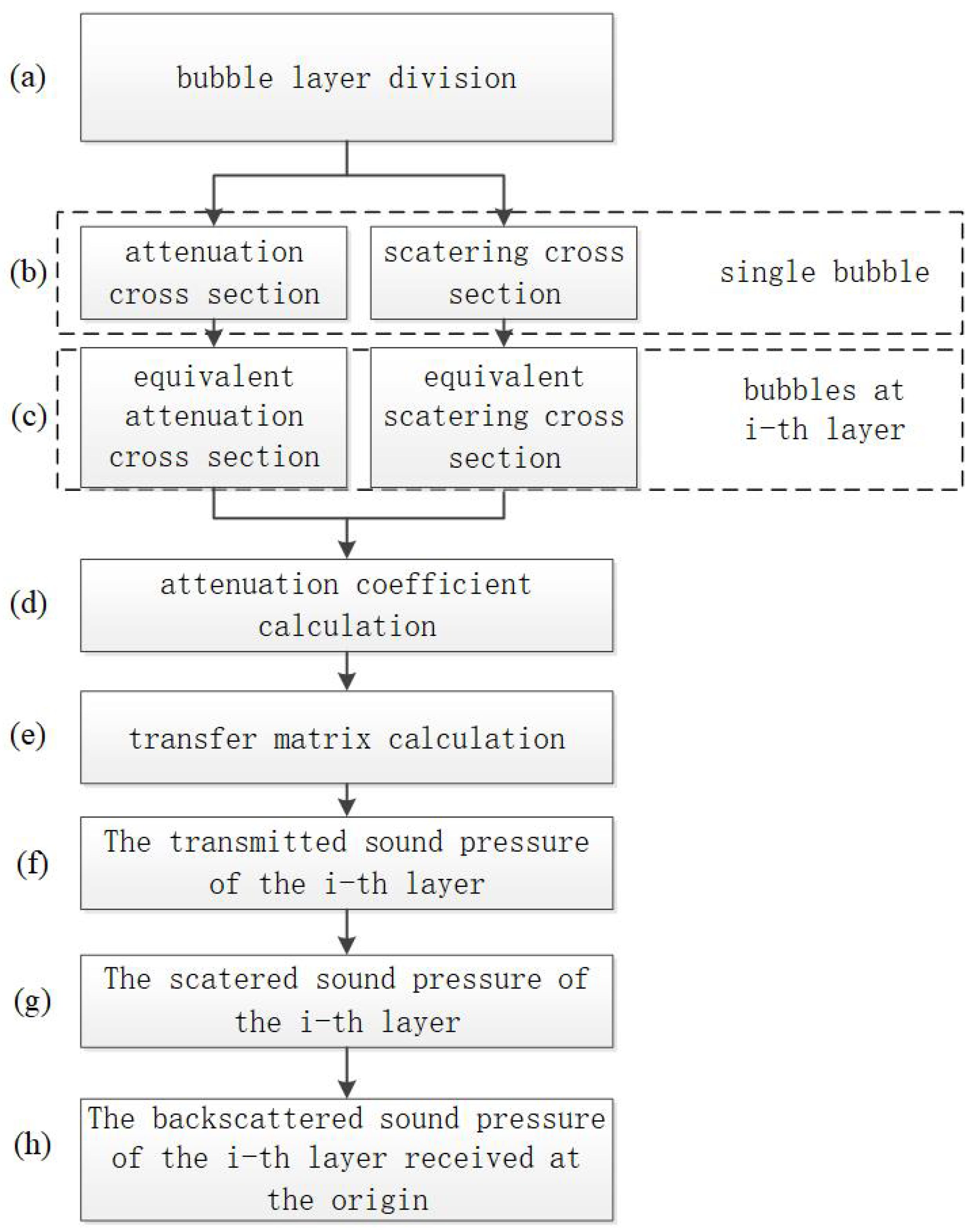
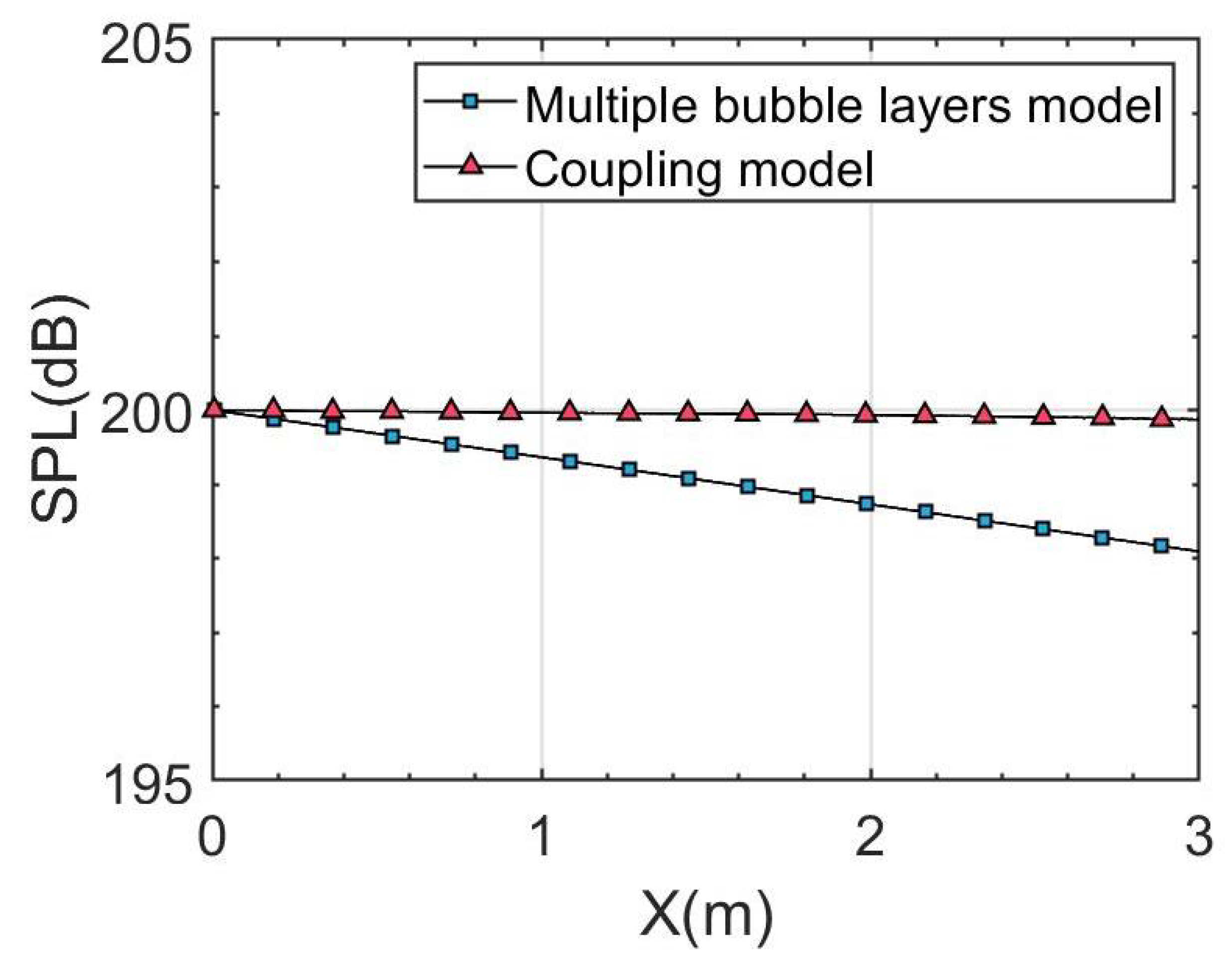

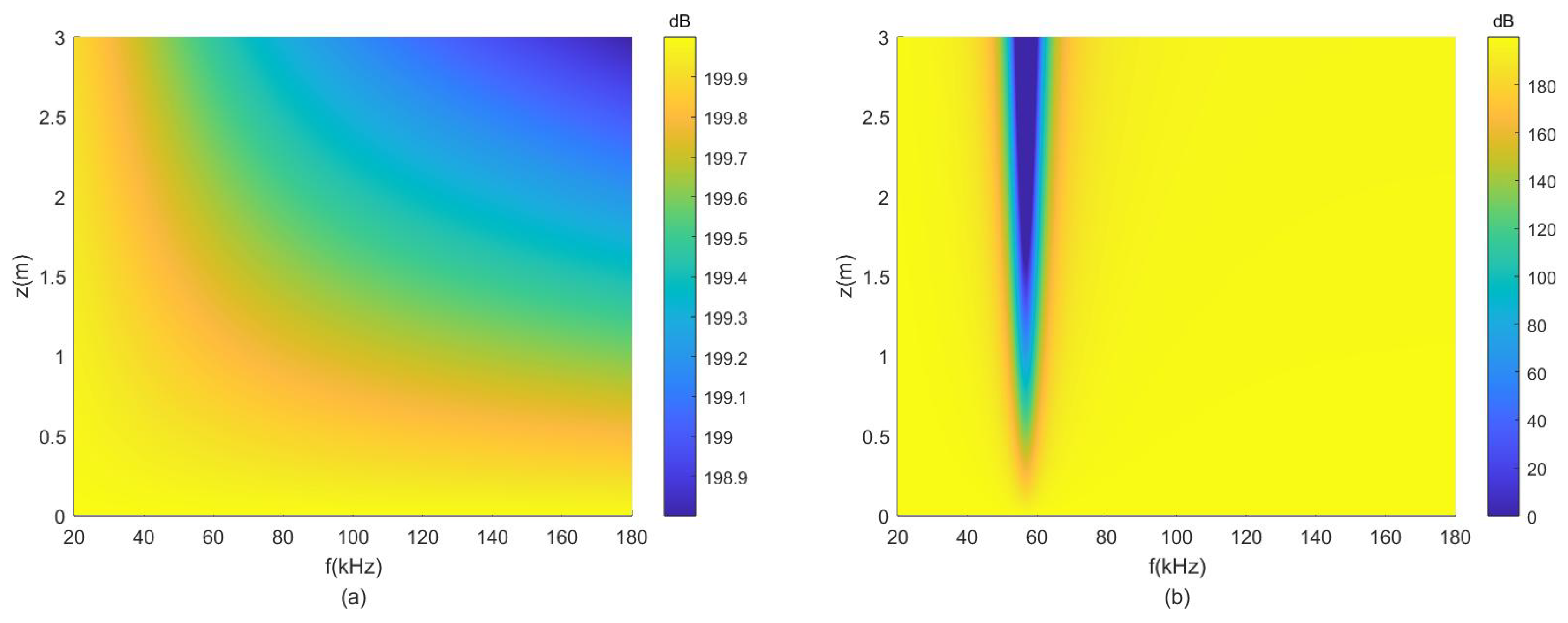
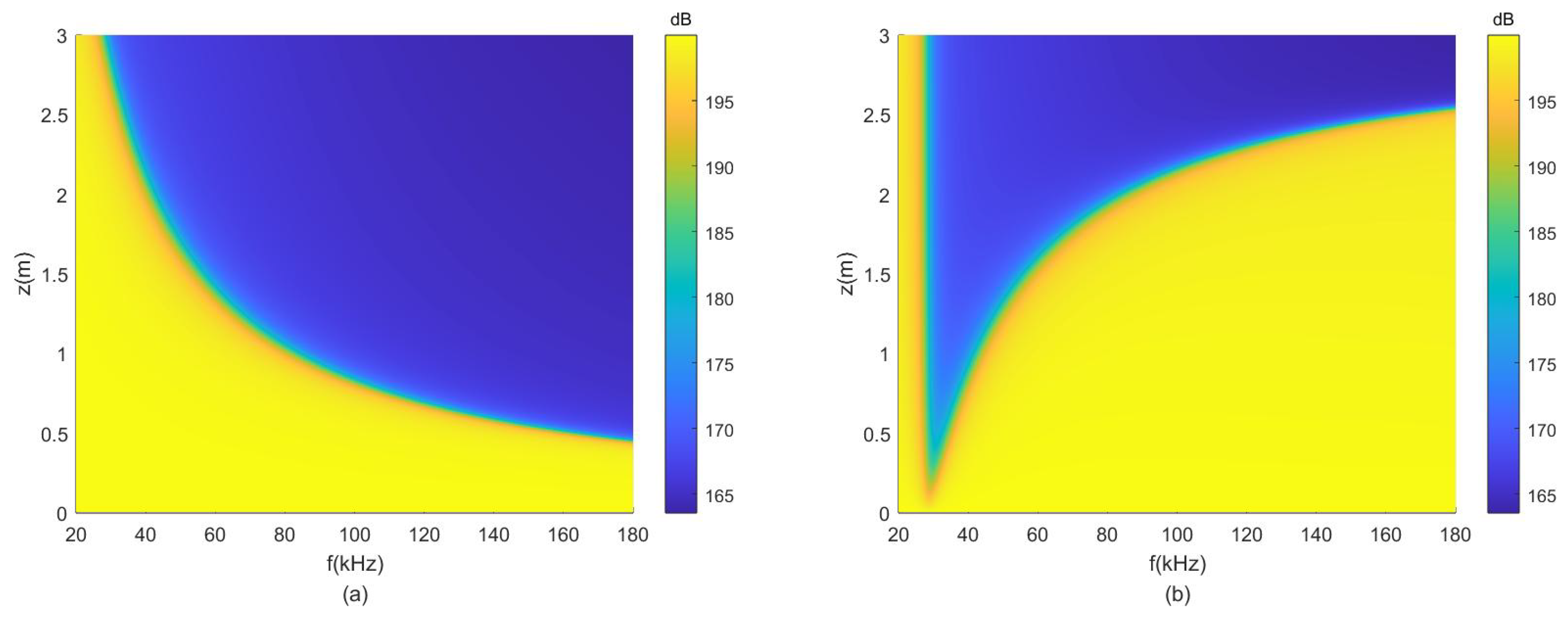
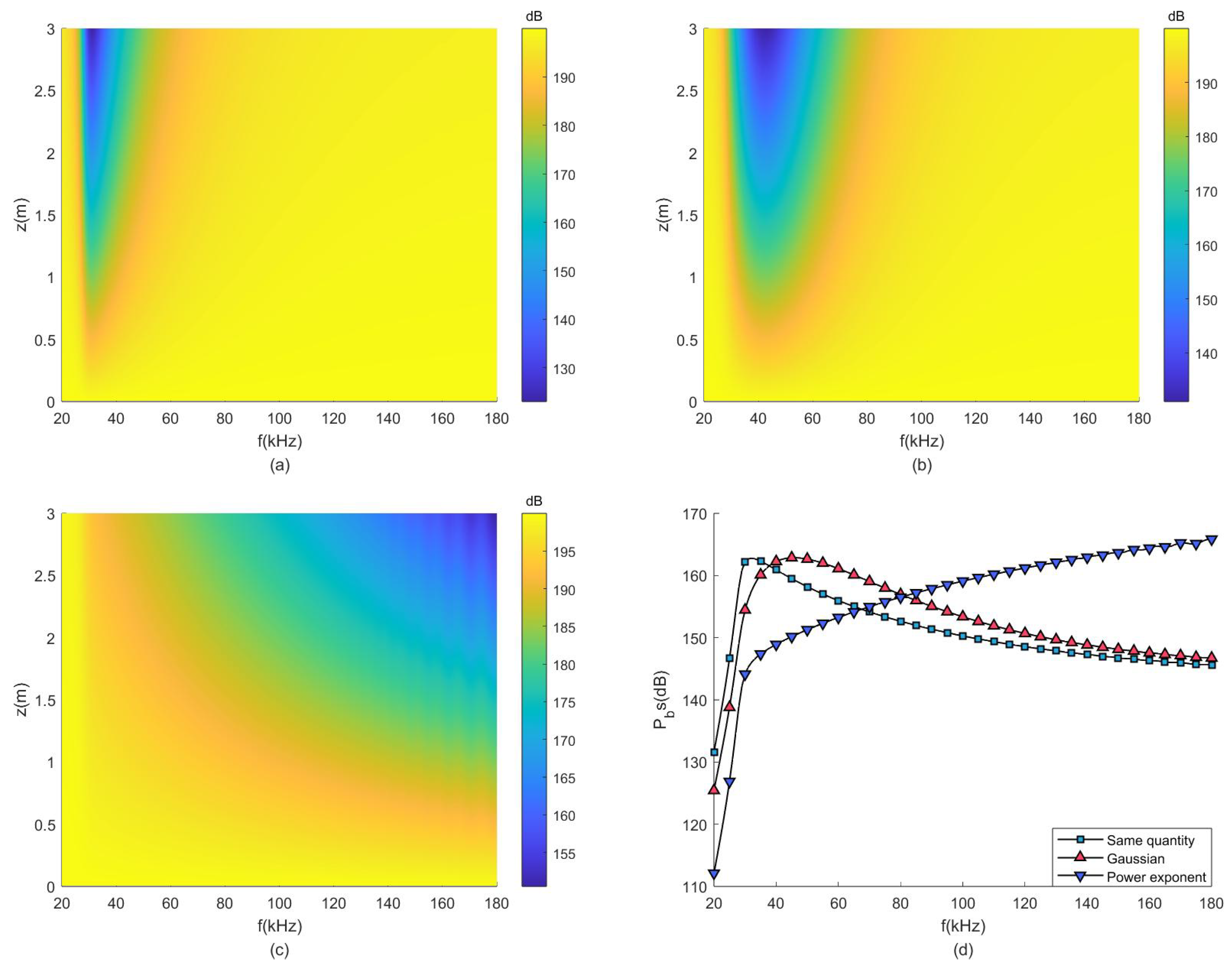
| Parameter | Value | Definition |
|---|---|---|
| 1480 | sound speed in a pure water | |
| 340 | sound speed of air | |
| 1.4 | the specific heat ratio of air | |
| 998 | the density of water | |
| 1.29 | the density of air | |
| the shear viscosity coefficient | ||
| the thermal conductivity | ||
| 0.24 | the specific heat capacity |
| Model | Distance (m) | Calculation Time (s) | Required Memory (GB) |
|---|---|---|---|
| the multiple bubble layer model | 6 | 0.47 | 0.1083 |
| the coupling model | 6 | 1.34 | 0.1194 |
| the multiple bubble layer model | 60 | 3.83 | 1.0826 |
| the coupling model | 60 | 1597.19 | 11.9226 |
Disclaimer/Publisher’s Note: The statements, opinions and data contained in all publications are solely those of the individual author(s) and contributor(s) and not of MDPI and/or the editor(s). MDPI and/or the editor(s) disclaim responsibility for any injury to people or property resulting from any ideas, methods, instructions or products referred to in the content. |
© 2024 by the authors. Licensee MDPI, Basel, Switzerland. This article is an open access article distributed under the terms and conditions of the Creative Commons Attribution (CC BY) license (https://creativecommons.org/licenses/by/4.0/).
Share and Cite
Cheng, Y.; Shi, J.; Cao, Y.; Zhang, H. Predictions of the Effect of Non-Homogeneous Ocean Bubbles on Sound Propagation. J. Mar. Sci. Eng. 2024, 12, 1510. https://doi.org/10.3390/jmse12091510
Cheng Y, Shi J, Cao Y, Zhang H. Predictions of the Effect of Non-Homogeneous Ocean Bubbles on Sound Propagation. Journal of Marine Science and Engineering. 2024; 12(9):1510. https://doi.org/10.3390/jmse12091510
Chicago/Turabian StyleCheng, Yuezhu, Jie Shi, Yuan Cao, and Haoyang Zhang. 2024. "Predictions of the Effect of Non-Homogeneous Ocean Bubbles on Sound Propagation" Journal of Marine Science and Engineering 12, no. 9: 1510. https://doi.org/10.3390/jmse12091510





